Literature Review: Metabolomics of Dealcoholized Wine on Heart Health
VerifiedAdded on 2023/06/18
|7
|1415
|287
Literature Review
AI Summary
This literature review examines the impact of dealcoholized wine consumption on cardiovascular health, drawing from various studies on the topic. It explores the potential benefits of dealcoholized wine, particularly red wine, in preventing cardiovascular disease and improving heart health by affecting blood pressure and cholesterol levels. The review also discusses the role of metabolomics in understanding how dealcoholized wine influences the urinary metabolome and the excretion of microbial phenolic metabolites. While moderate alcohol consumption may offer some benefits, the review highlights that excessive alcohol intake can negatively impact cardiovascular health, emphasizing the importance of consuming alcohol in moderation or opting for dealcoholized alternatives. Desklib provides access to this and other solved assignments.
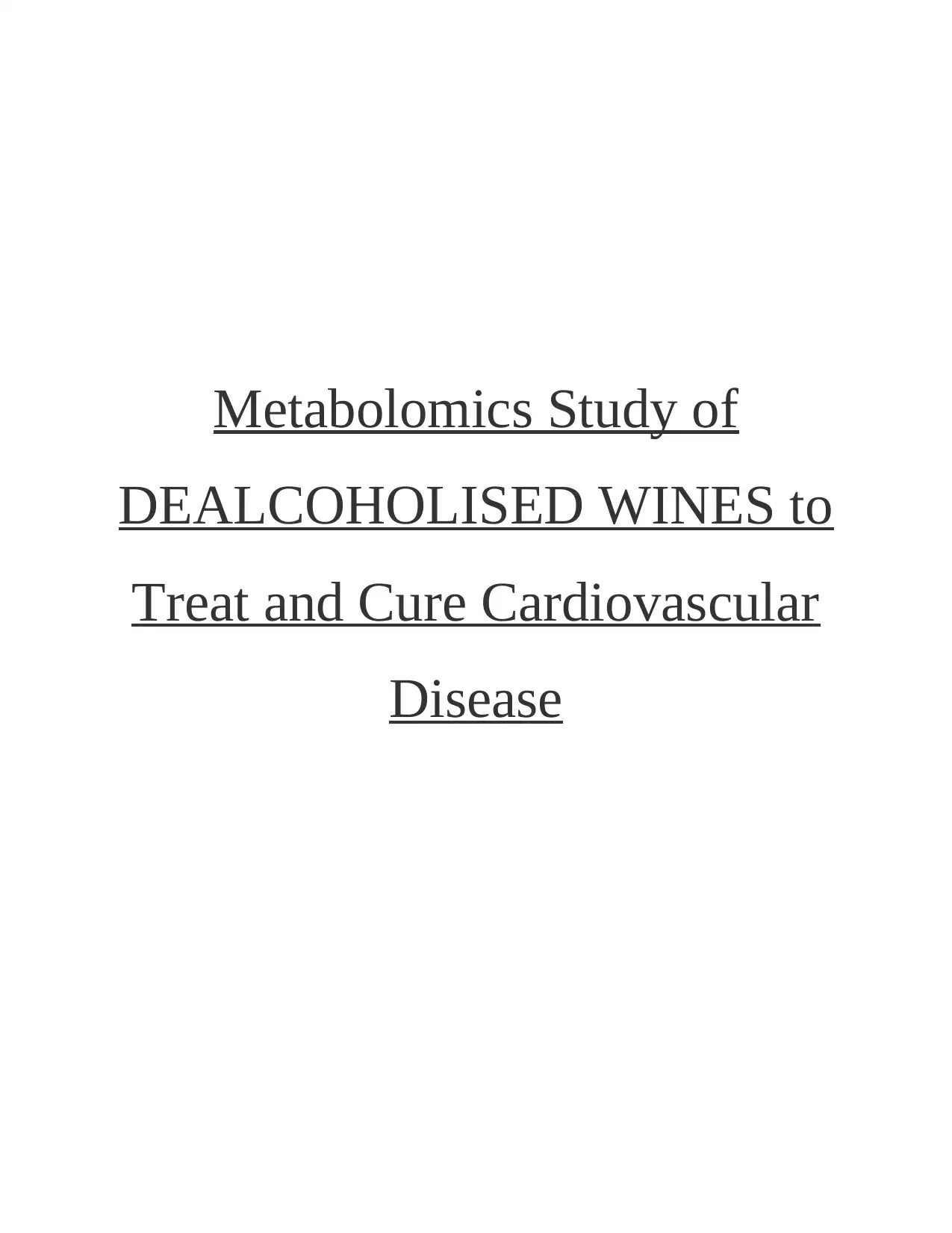
Metabolomics Study of
DEALCOHOLISED WINES to
Treat and Cure Cardiovascular
Disease
DEALCOHOLISED WINES to
Treat and Cure Cardiovascular
Disease
Paraphrase This Document
Need a fresh take? Get an instant paraphrase of this document with our AI Paraphraser
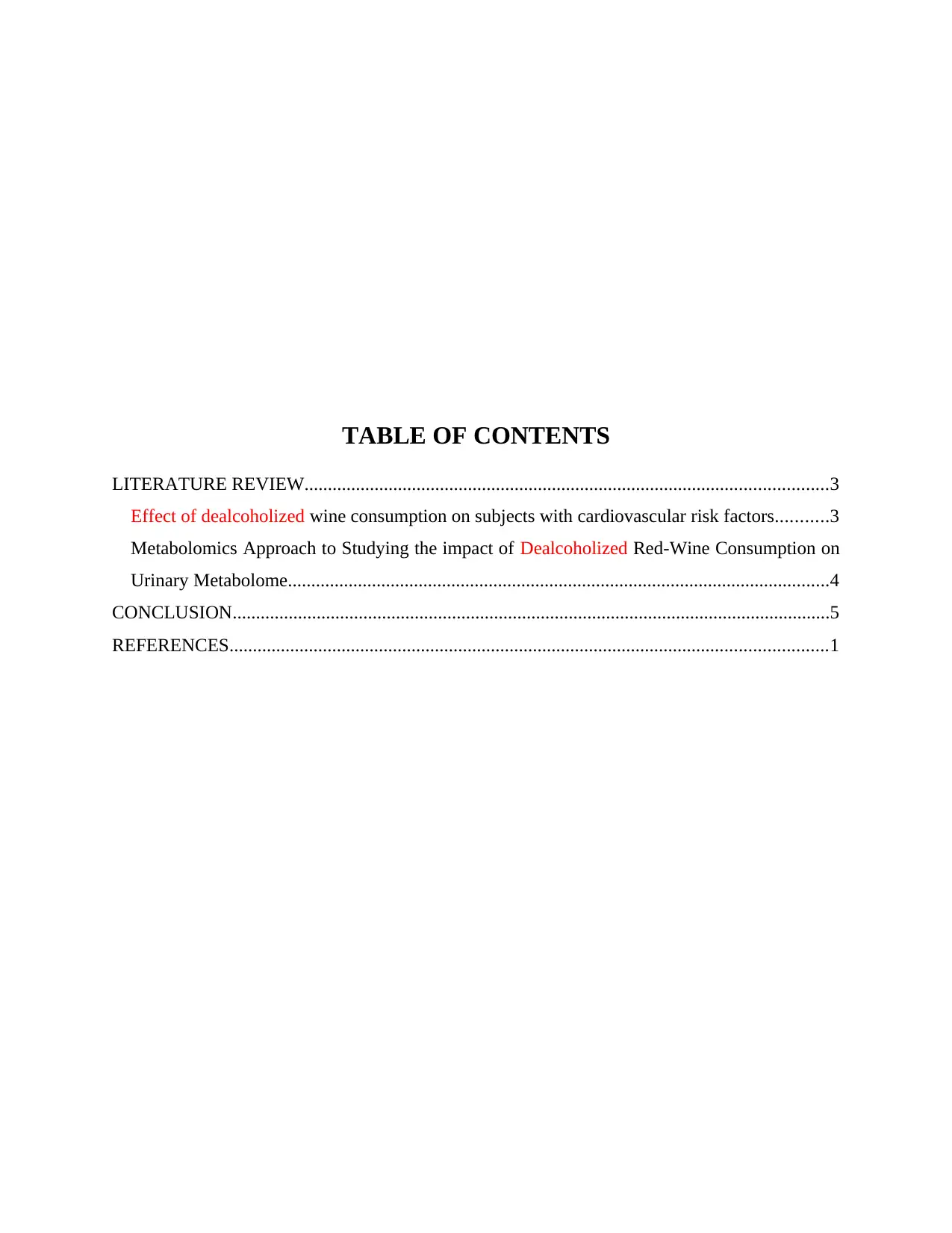
TABLE OF CONTENTS
LITERATURE REVIEW................................................................................................................3
Effect of dealcoholized wine consumption on subjects with cardiovascular risk factors...........3
Metabolomics Approach to Studying the impact of Dealcoholized Red-Wine Consumption on
Urinary Metabolome....................................................................................................................4
CONCLUSION................................................................................................................................5
REFERENCES................................................................................................................................1
LITERATURE REVIEW................................................................................................................3
Effect of dealcoholized wine consumption on subjects with cardiovascular risk factors...........3
Metabolomics Approach to Studying the impact of Dealcoholized Red-Wine Consumption on
Urinary Metabolome....................................................................................................................4
CONCLUSION................................................................................................................................5
REFERENCES................................................................................................................................1
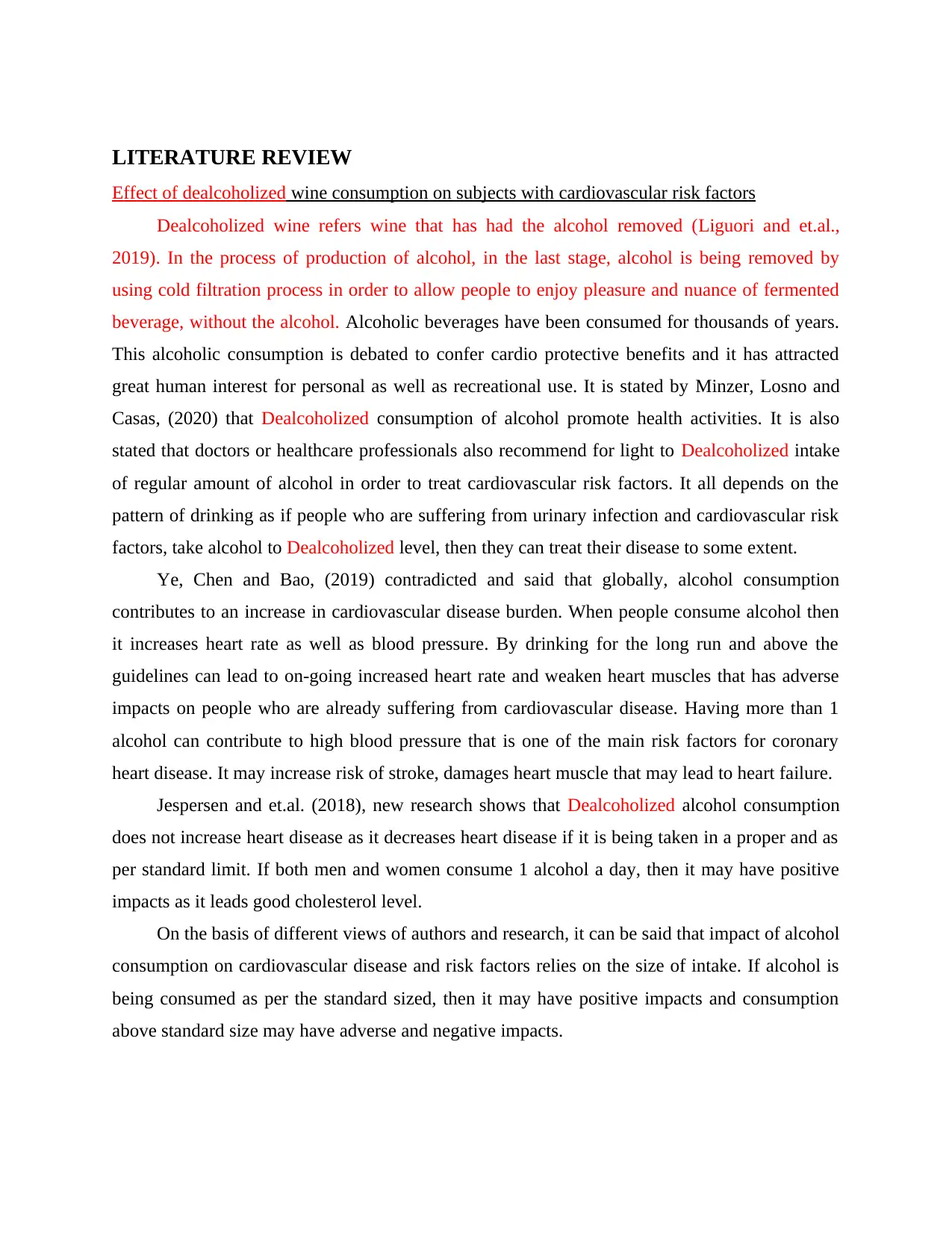
LITERATURE REVIEW
Effect of dealcoholized wine consumption on subjects with cardiovascular risk factors
Dealcoholized wine refers wine that has had the alcohol removed (Liguori and et.al.,
2019). In the process of production of alcohol, in the last stage, alcohol is being removed by
using cold filtration process in order to allow people to enjoy pleasure and nuance of fermented
beverage, without the alcohol. Alcoholic beverages have been consumed for thousands of years.
This alcoholic consumption is debated to confer cardio protective benefits and it has attracted
great human interest for personal as well as recreational use. It is stated by Minzer, Losno and
Casas, (2020) that Dealcoholized consumption of alcohol promote health activities. It is also
stated that doctors or healthcare professionals also recommend for light to Dealcoholized intake
of regular amount of alcohol in order to treat cardiovascular risk factors. It all depends on the
pattern of drinking as if people who are suffering from urinary infection and cardiovascular risk
factors, take alcohol to Dealcoholized level, then they can treat their disease to some extent.
Ye, Chen and Bao, (2019) contradicted and said that globally, alcohol consumption
contributes to an increase in cardiovascular disease burden. When people consume alcohol then
it increases heart rate as well as blood pressure. By drinking for the long run and above the
guidelines can lead to on-going increased heart rate and weaken heart muscles that has adverse
impacts on people who are already suffering from cardiovascular disease. Having more than 1
alcohol can contribute to high blood pressure that is one of the main risk factors for coronary
heart disease. It may increase risk of stroke, damages heart muscle that may lead to heart failure.
Jespersen and et.al. (2018), new research shows that Dealcoholized alcohol consumption
does not increase heart disease as it decreases heart disease if it is being taken in a proper and as
per standard limit. If both men and women consume 1 alcohol a day, then it may have positive
impacts as it leads good cholesterol level.
On the basis of different views of authors and research, it can be said that impact of alcohol
consumption on cardiovascular disease and risk factors relies on the size of intake. If alcohol is
being consumed as per the standard sized, then it may have positive impacts and consumption
above standard size may have adverse and negative impacts.
Effect of dealcoholized wine consumption on subjects with cardiovascular risk factors
Dealcoholized wine refers wine that has had the alcohol removed (Liguori and et.al.,
2019). In the process of production of alcohol, in the last stage, alcohol is being removed by
using cold filtration process in order to allow people to enjoy pleasure and nuance of fermented
beverage, without the alcohol. Alcoholic beverages have been consumed for thousands of years.
This alcoholic consumption is debated to confer cardio protective benefits and it has attracted
great human interest for personal as well as recreational use. It is stated by Minzer, Losno and
Casas, (2020) that Dealcoholized consumption of alcohol promote health activities. It is also
stated that doctors or healthcare professionals also recommend for light to Dealcoholized intake
of regular amount of alcohol in order to treat cardiovascular risk factors. It all depends on the
pattern of drinking as if people who are suffering from urinary infection and cardiovascular risk
factors, take alcohol to Dealcoholized level, then they can treat their disease to some extent.
Ye, Chen and Bao, (2019) contradicted and said that globally, alcohol consumption
contributes to an increase in cardiovascular disease burden. When people consume alcohol then
it increases heart rate as well as blood pressure. By drinking for the long run and above the
guidelines can lead to on-going increased heart rate and weaken heart muscles that has adverse
impacts on people who are already suffering from cardiovascular disease. Having more than 1
alcohol can contribute to high blood pressure that is one of the main risk factors for coronary
heart disease. It may increase risk of stroke, damages heart muscle that may lead to heart failure.
Jespersen and et.al. (2018), new research shows that Dealcoholized alcohol consumption
does not increase heart disease as it decreases heart disease if it is being taken in a proper and as
per standard limit. If both men and women consume 1 alcohol a day, then it may have positive
impacts as it leads good cholesterol level.
On the basis of different views of authors and research, it can be said that impact of alcohol
consumption on cardiovascular disease and risk factors relies on the size of intake. If alcohol is
being consumed as per the standard sized, then it may have positive impacts and consumption
above standard size may have adverse and negative impacts.
⊘ This is a preview!⊘
Do you want full access?
Subscribe today to unlock all pages.

Trusted by 1+ million students worldwide
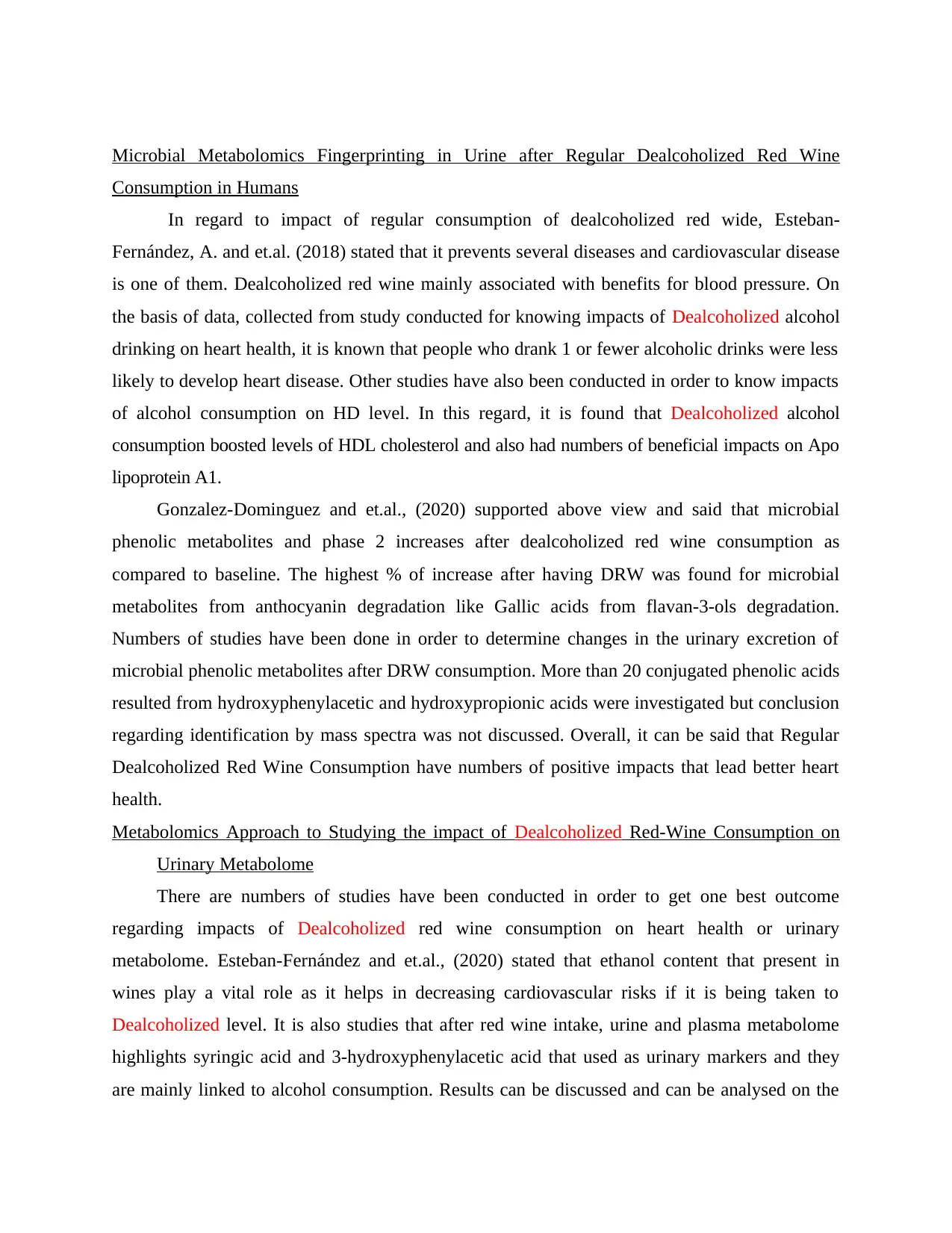
Microbial Metabolomics Fingerprinting in Urine after Regular Dealcoholized Red Wine
Consumption in Humans
In regard to impact of regular consumption of dealcoholized red wide, Esteban-
Fernández, A. and et.al. (2018 ) stated that it prevents several diseases and cardiovascular disease
is one of them. Dealcoholized red wine mainly associated with benefits for blood pressure. On
the basis of data, collected from study conducted for knowing impacts of Dealcoholized alcohol
drinking on heart health, it is known that people who drank 1 or fewer alcoholic drinks were less
likely to develop heart disease. Other studies have also been conducted in order to know impacts
of alcohol consumption on HD level. In this regard, it is found that Dealcoholized alcohol
consumption boosted levels of HDL cholesterol and also had numbers of beneficial impacts on Apo
lipoprotein A1.
Gonzalez-Dominguez and et.al., (2020) supported above view and said that microbial
phenolic metabolites and phase 2 increases after dealcoholized red wine consumption as
compared to baseline. The highest % of increase after having DRW was found for microbial
metabolites from anthocyanin degradation like Gallic acids from flavan-3-ols degradation.
Numbers of studies have been done in order to determine changes in the urinary excretion of
microbial phenolic metabolites after DRW consumption. More than 20 conjugated phenolic acids
resulted from hydroxyphenylacetic and hydroxypropionic acids were investigated but conclusion
regarding identification by mass spectra was not discussed. Overall, it can be said that Regular
Dealcoholized Red Wine Consumption have numbers of positive impacts that lead better heart
health.
Metabolomics Approach to Studying the impact of Dealcoholized Red-Wine Consumption on
Urinary Metabolome
There are numbers of studies have been conducted in order to get one best outcome
regarding impacts of Dealcoholized red wine consumption on heart health or urinary
metabolome. Esteban-Ferná ndez and et.al., (2020) stated that ethanol content that present in
wines play a vital role as it helps in decreasing cardiovascular risks if it is being taken to
Dealcoholized level. It is also studies that after red wine intake, urine and plasma metabolome
highlights syringic acid and 3-hydroxyphenylacetic acid that used as urinary markers and they
are mainly linked to alcohol consumption. Results can be discussed and can be analysed on the
Consumption in Humans
In regard to impact of regular consumption of dealcoholized red wide, Esteban-
Fernández, A. and et.al. (2018 ) stated that it prevents several diseases and cardiovascular disease
is one of them. Dealcoholized red wine mainly associated with benefits for blood pressure. On
the basis of data, collected from study conducted for knowing impacts of Dealcoholized alcohol
drinking on heart health, it is known that people who drank 1 or fewer alcoholic drinks were less
likely to develop heart disease. Other studies have also been conducted in order to know impacts
of alcohol consumption on HD level. In this regard, it is found that Dealcoholized alcohol
consumption boosted levels of HDL cholesterol and also had numbers of beneficial impacts on Apo
lipoprotein A1.
Gonzalez-Dominguez and et.al., (2020) supported above view and said that microbial
phenolic metabolites and phase 2 increases after dealcoholized red wine consumption as
compared to baseline. The highest % of increase after having DRW was found for microbial
metabolites from anthocyanin degradation like Gallic acids from flavan-3-ols degradation.
Numbers of studies have been done in order to determine changes in the urinary excretion of
microbial phenolic metabolites after DRW consumption. More than 20 conjugated phenolic acids
resulted from hydroxyphenylacetic and hydroxypropionic acids were investigated but conclusion
regarding identification by mass spectra was not discussed. Overall, it can be said that Regular
Dealcoholized Red Wine Consumption have numbers of positive impacts that lead better heart
health.
Metabolomics Approach to Studying the impact of Dealcoholized Red-Wine Consumption on
Urinary Metabolome
There are numbers of studies have been conducted in order to get one best outcome
regarding impacts of Dealcoholized red wine consumption on heart health or urinary
metabolome. Esteban-Ferná ndez and et.al., (2020) stated that ethanol content that present in
wines play a vital role as it helps in decreasing cardiovascular risks if it is being taken to
Dealcoholized level. It is also studies that after red wine intake, urine and plasma metabolome
highlights syringic acid and 3-hydroxyphenylacetic acid that used as urinary markers and they
are mainly linked to alcohol consumption. Results can be discussed and can be analysed on the
Paraphrase This Document
Need a fresh take? Get an instant paraphrase of this document with our AI Paraphraser
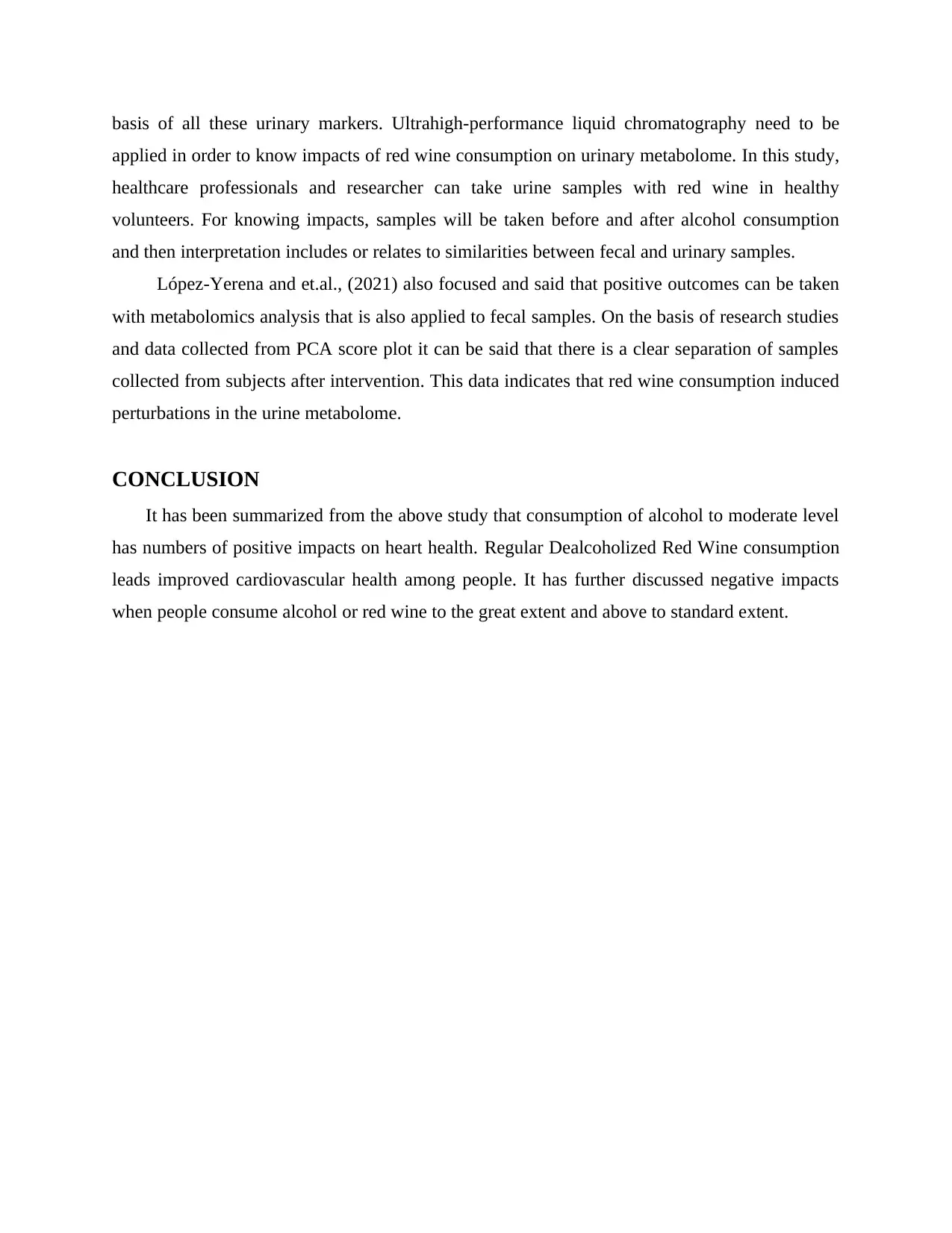
basis of all these urinary markers. Ultrahigh-performance liquid chromatography need to be
applied in order to know impacts of red wine consumption on urinary metabolome. In this study,
healthcare professionals and researcher can take urine samples with red wine in healthy
volunteers. For knowing impacts, samples will be taken before and after alcohol consumption
and then interpretation includes or relates to similarities between fecal and urinary samples.
López-Yerena and et.al., (2021) also focused and said that positive outcomes can be taken
with metabolomics analysis that is also applied to fecal samples. On the basis of research studies
and data collected from PCA score plot it can be said that there is a clear separation of samples
collected from subjects after intervention. This data indicates that red wine consumption induced
perturbations in the urine metabolome.
CONCLUSION
It has been summarized from the above study that consumption of alcohol to moderate level
has numbers of positive impacts on heart health. Regular Dealcoholized Red Wine consumption
leads improved cardiovascular health among people. It has further discussed negative impacts
when people consume alcohol or red wine to the great extent and above to standard extent.
applied in order to know impacts of red wine consumption on urinary metabolome. In this study,
healthcare professionals and researcher can take urine samples with red wine in healthy
volunteers. For knowing impacts, samples will be taken before and after alcohol consumption
and then interpretation includes or relates to similarities between fecal and urinary samples.
López-Yerena and et.al., (2021) also focused and said that positive outcomes can be taken
with metabolomics analysis that is also applied to fecal samples. On the basis of research studies
and data collected from PCA score plot it can be said that there is a clear separation of samples
collected from subjects after intervention. This data indicates that red wine consumption induced
perturbations in the urine metabolome.
CONCLUSION
It has been summarized from the above study that consumption of alcohol to moderate level
has numbers of positive impacts on heart health. Regular Dealcoholized Red Wine consumption
leads improved cardiovascular health among people. It has further discussed negative impacts
when people consume alcohol or red wine to the great extent and above to standard extent.
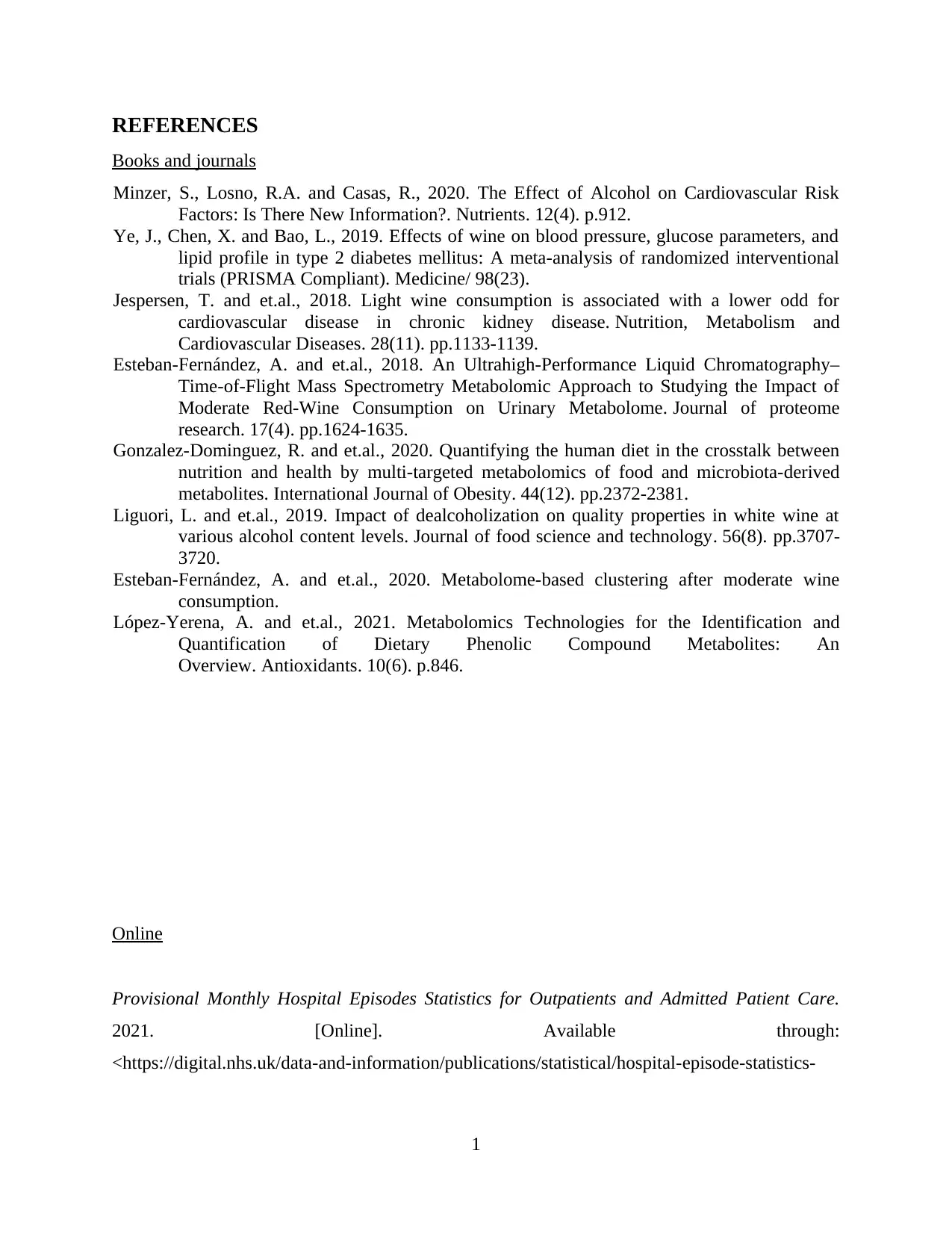
REFERENCES
Books and journals
Minzer, S., Losno, R.A. and Casas, R., 2020. The Effect of Alcohol on Cardiovascular Risk
Factors: Is There New Information?. Nutrients. 12(4). p.912.
Ye, J., Chen, X. and Bao, L., 2019. Effects of wine on blood pressure, glucose parameters, and
lipid profile in type 2 diabetes mellitus: A meta-analysis of randomized interventional
trials (PRISMA Compliant). Medicine/ 98(23).
Jespersen, T. and et.al., 2018. Light wine consumption is associated with a lower odd for
cardiovascular disease in chronic kidney disease. Nutrition, Metabolism and
Cardiovascular Diseases. 28(11). pp.1133-1139.
Esteban-Fernández, A. and et.al., 2018. An Ultrahigh-Performance Liquid Chromatography–
Time-of-Flight Mass Spectrometry Metabolomic Approach to Studying the Impact of
Moderate Red-Wine Consumption on Urinary Metabolome. Journal of proteome
research. 17(4). pp.1624-1635.
Gonzalez-Dominguez, R. and et.al., 2020. Quantifying the human diet in the crosstalk between
nutrition and health by multi-targeted metabolomics of food and microbiota-derived
metabolites. International Journal of Obesity. 44(12). pp.2372-2381.
Liguori, L. and et.al., 2019. Impact of dealcoholization on quality properties in white wine at
various alcohol content levels. Journal of food science and technology. 56(8). pp.3707-
3720.
Esteban-Ferná ndez, A. and et.al., 2020. Metabolome-based clustering after moderate wine
consumption.
López-Yerena, A. and et.al., 2021. Metabolomics Technologies for the Identification and
Quantification of Dietary Phenolic Compound Metabolites: An
Overview. Antioxidants. 10(6). p.846.
Online
Provisional Monthly Hospital Episodes Statistics for Outpatients and Admitted Patient Care.
2021. [Online]. Available through:
<https://digital.nhs.uk/data-and-information/publications/statistical/hospital-episode-statistics-
1
Books and journals
Minzer, S., Losno, R.A. and Casas, R., 2020. The Effect of Alcohol on Cardiovascular Risk
Factors: Is There New Information?. Nutrients. 12(4). p.912.
Ye, J., Chen, X. and Bao, L., 2019. Effects of wine on blood pressure, glucose parameters, and
lipid profile in type 2 diabetes mellitus: A meta-analysis of randomized interventional
trials (PRISMA Compliant). Medicine/ 98(23).
Jespersen, T. and et.al., 2018. Light wine consumption is associated with a lower odd for
cardiovascular disease in chronic kidney disease. Nutrition, Metabolism and
Cardiovascular Diseases. 28(11). pp.1133-1139.
Esteban-Fernández, A. and et.al., 2018. An Ultrahigh-Performance Liquid Chromatography–
Time-of-Flight Mass Spectrometry Metabolomic Approach to Studying the Impact of
Moderate Red-Wine Consumption on Urinary Metabolome. Journal of proteome
research. 17(4). pp.1624-1635.
Gonzalez-Dominguez, R. and et.al., 2020. Quantifying the human diet in the crosstalk between
nutrition and health by multi-targeted metabolomics of food and microbiota-derived
metabolites. International Journal of Obesity. 44(12). pp.2372-2381.
Liguori, L. and et.al., 2019. Impact of dealcoholization on quality properties in white wine at
various alcohol content levels. Journal of food science and technology. 56(8). pp.3707-
3720.
Esteban-Ferná ndez, A. and et.al., 2020. Metabolome-based clustering after moderate wine
consumption.
López-Yerena, A. and et.al., 2021. Metabolomics Technologies for the Identification and
Quantification of Dietary Phenolic Compound Metabolites: An
Overview. Antioxidants. 10(6). p.846.
Online
Provisional Monthly Hospital Episodes Statistics for Outpatients and Admitted Patient Care.
2021. [Online]. Available through:
<https://digital.nhs.uk/data-and-information/publications/statistical/hospital-episode-statistics-
1
⊘ This is a preview!⊘
Do you want full access?
Subscribe today to unlock all pages.

Trusted by 1+ million students worldwide

for-admitted-patient-care-outpatient-and-accident-and-emergency-data/april-2020---march-
2021>
2
2021>
2
1 out of 7
Related Documents
Your All-in-One AI-Powered Toolkit for Academic Success.
+13062052269
info@desklib.com
Available 24*7 on WhatsApp / Email
![[object Object]](/_next/static/media/star-bottom.7253800d.svg)
Unlock your academic potential
Copyright © 2020–2025 A2Z Services. All Rights Reserved. Developed and managed by ZUCOL.





